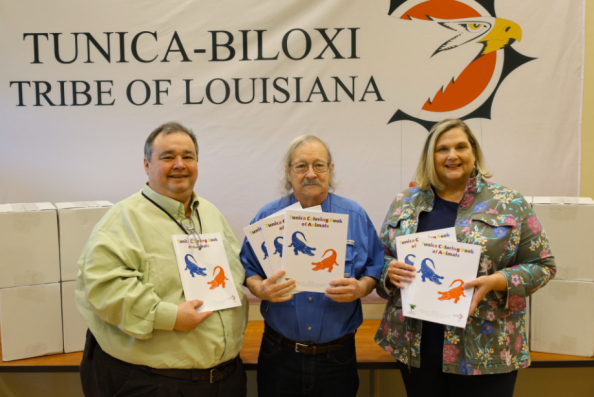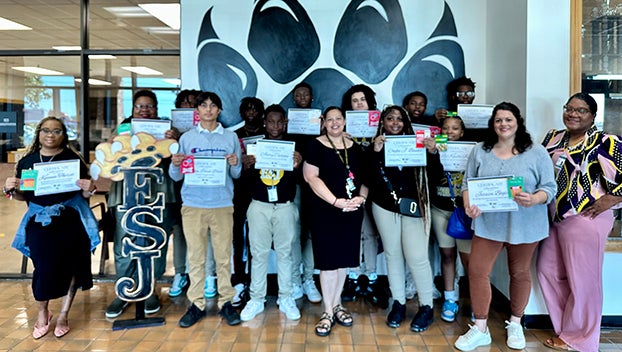LWF, Tunica-Biloxi Tribe Publish Coloring Book To Help Reawaken Tunica Language
Published 8:30 am Sunday, October 9, 2022
|
Getting your Trinity Audio player ready...
|
MARKSVILLE – The Tunica-Biloxi Tribe of Louisiana and Louisiana Wildlife Federation (LWF) have published a 64-page educational coloring book that depicts native Louisiana wildlife while helping reawaken the Tunica language.
“Recognizing our shared interest in native wildlife, this was a natural opportunity for LWF to work with the Tunica-Biloxi Tribe of Louisiana,” Rebecca Triche, executive director of LWF said. “The book not only serves as a way to educate about Louisiana’s native wildlife but to also help reawaken the Tunica language for indigenous youth in the Language and Culture Revitalization Program (LCRP).”
The collaboration for the book between the Tunica-Biloxi and LWF began in early 2021 when Marty Floyd, a board member for LWF and its representative to the National Wildlife Federation (NWF), got the idea during a NWF call.
“I heard affiliates in some Western states talking about ways they had worked with the indigenous people in their region to help bring Buffalo back to Yellowstone National Park,” Floyd said. “I knew we needed to do something here in Louisiana and knew the Tunica-Biloxi was working to bring their language back.”
Afterward, Floyd reached out to the Tunica-Biloxi to see how LWF could assist the tribe based in Marksville. The result: a book using drawings to help teach the name and pronunciation of native Louisiana animals in the Tunica language.
Efforts to reawaken the Tunica language began in 2010 with Kuhpani Yoyani Luhchi Yoroni (KYLY), a working group comprised of Tunica-Biloxi community members and Tulane University linguists, also known as the Tunica Language Project. One of the most remarkable components of this department is the Tribe’s LCRP which successfully revived the Tunica language from “dormant” to “awakened,” a very rare occurrence in the linguistic community.
Due to the hard work and dedication of John Barbry, director of development and programming for the Tunica-Biloxi Tribe of Louisiana, and the LCRP team, there are now over 50 active speakers of the Tunica language and in-house linguists who teach the language and work to expand the program.
“A pillar of the Tunica-Biloxi Tribe has always been education – of Tribal citizens and the local community,” said John Barbry, Director of the Tunica-Biloxi Language and Culture Revitalization Program. “This collaboration effort furthers our ultimate goal – increasing awareness and education of the Tunica Language.”
The cover of the educational book features a red and blue alligator, which represents a part of the original Tunica creation story. Overall, Floyd provided 59 original illustrations inside the book featuring mammals, then birds, reptiles and amphibians, fish, and insects in that order.
Each page has a simple drawing that can be colored, along with the name of the animal in the Tunica language. Some examples of animals featured in the book include a chahki (flying squirrel), a chomu (bobcat), a nara (snake), watoruhki (great blue heron), a yanishkashi (bison) and a yishi (raccoon).
An index of the animal’s name in both the Tunica and English languages is found inside the back cover, as well as a pronunciation key for the vowels and consonant letters in the Tunica language.
Louisiana educators can use the book as part of meeting education standards in social studies (Grades 1,2,3 and 5) and Science (Grade 2).
The book was made possible with support from the Tunica-Biloxi Tribe of Louisiana, Louisiana Wildlife Federation, the National Wildlife Federation and the Rapides Wildlife Association.
The books are being distributed by the Tunica-Biloxi Tribe of Louisiana and can also be found in the gift shop at the Tunica-Biloxi Resort in Marksville. A digital version of the book can be downloaded at lawildlifefed.org/resources or at Tunicabiloxi.org.
# # #
Tagline for photo link at top of release — Louisiana Wildlife Federation Executive Director Rebecca Triche (right) and LWF Board Member Marty Floyd (center), who illustrated the Tunica Coloring Book of Animals, deliver several boxes of the published book to John Barbry, Director of the Tunica-Biloxi Language and Culture Revitalization Program.
About the Tunica-Biloxi Tribe of LA
The Tunica-Biloxi people first appeared in the Mississippi Valley. In the late 1700s, they settled near Marksville, where they were skilled traders and entrepreneurs. Today, the Tribe has more than 1,500 members throughout the United States, primarily in Louisiana, Texas and Illinois.
The Tunica-Biloxi Tribe received federal recognition in 1981 for its reservation within the boundaries of Louisiana. The tribe owns and operates the Paragon Casino Resort, the largest employer in Central Louisiana. Through its compact, negotiated by the late Tribal Chairman Earl J. Barbry Sr. and the State of Louisiana, the Tribe has assisted local governments in the area with its quarterly distribution of funds, totaling more than $40 million over two decades. For more information about the Tunica-Biloxi Tribe of Louisiana, visit www.tunica.org and “like” us on Facebook.
About Louisiana Wildlife Federation
Established in 1940, Louisiana Wildlife Federation is a statewide nonprofit organization that represents 19 affiliate organizations and more than 7,900 members dedicated to the conservation of Louisiana’s wildlife and natural resources.
Louisiana Wildlife Federation is an affiliate of National Wildlife Federation and together we form a powerful network for conservation locally and nationally.





